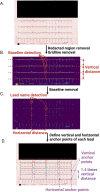A fully-automated paper ECG digitisation algorithm using deep learning
- PMID: 36471089
- PMCID: PMC9722713
- DOI: 10.1038/s41598-022-25284-1
A fully-automated paper ECG digitisation algorithm using deep learning
Abstract
There is increasing focus on applying deep learning methods to electrocardiograms (ECGs), with recent studies showing that neural networks (NNs) can predict future heart failure or atrial fibrillation from the ECG alone. However, large numbers of ECGs are needed to train NNs, and many ECGs are currently only in paper format, which are not suitable for NN training. We developed a fully-automated online ECG digitisation tool to convert scanned paper ECGs into digital signals. Using automated horizontal and vertical anchor point detection, the algorithm automatically segments the ECG image into separate images for the 12 leads and a dynamical morphological algorithm is then applied to extract the signal of interest. We then validated the performance of the algorithm on 515 digital ECGs, of which 45 were printed, scanned and redigitised. The automated digitisation tool achieved 99.0% correlation between the digitised signals and the ground truth ECG (n = 515 standard 3-by-4 ECGs) after excluding ECGs with overlap of lead signals. Without exclusion, the performance of average correlation was from 90 to 97% across the leads on all 3-by-4 ECGs. There was a 97% correlation for 12-by-1 and 3-by-1 ECG formats after excluding ECGs with overlap of lead signals. Without exclusion, the average correlation of some leads in 12-by-1 ECGs was 60-70% and the average correlation of 3-by-1 ECGs achieved 80-90%. ECGs that were printed, scanned, and redigitised, our tool achieved 96% correlation with the original signals. We have developed and validated a fully-automated, user-friendly, online ECG digitisation tool. Unlike other available tools, this does not require any manual segmentation of ECG signals. Our tool can facilitate the rapid and automated digitisation of large repositories of paper ECGs to allow them to be used for deep learning projects.
© 2022. The Author(s).
Conflict of interest statement
The authors declare no competing interests.
Figures





Similar articles
-
An artificial intelligence-enabled ECG algorithm for the identification of patients with atrial fibrillation during sinus rhythm: a retrospective analysis of outcome prediction.Lancet. 2019 Sep 7;394(10201):861-867. doi: 10.1016/S0140-6736(19)31721-0. Epub 2019 Aug 1. Lancet. 2019. PMID: 31378392
-
High precision ECG digitization using artificial intelligence.J Electrocardiol. 2025 May-Jun;90:153900. doi: 10.1016/j.jelectrocard.2025.153900. Epub 2025 Feb 19. J Electrocardiol. 2025. PMID: 40010101
-
Safe automatic one-lead electrocardiogram analysis in screening for atrial fibrillation.Europace. 2017 Sep 1;19(9):1449-1453. doi: 10.1093/europace/euw286. Europace. 2017. PMID: 28339578
-
Review of Deep Learning-Based Atrial Fibrillation Detection Studies.Int J Environ Res Public Health. 2021 Oct 28;18(21):11302. doi: 10.3390/ijerph182111302. Int J Environ Res Public Health. 2021. PMID: 34769819 Free PMC article. Review.
-
Lead-I ECG for detecting atrial fibrillation in patients with an irregular pulse using single time point testing: a systematic review and economic evaluation.Health Technol Assess. 2020 Jan;24(3):1-164. doi: 10.3310/hta24030. Health Technol Assess. 2020. PMID: 31933471 Free PMC article.
Cited by
-
What Else Can AI See in a Digital ECG?J Pers Med. 2023 Jun 28;13(7):1059. doi: 10.3390/jpm13071059. J Pers Med. 2023. PMID: 37511672 Free PMC article. Review.
-
Machine learning discriminates P2X7-mediated intracellular calcium sparks in human-induced pluripotent stem cell-derived neural stem cells.Sci Rep. 2023 Aug 4;13(1):12673. doi: 10.1038/s41598-023-39846-4. Sci Rep. 2023. PMID: 37542080 Free PMC article.
-
GenECG: a synthetic image-based ECG dataset to augment artificial intelligence-enhanced algorithm development.BMJ Health Care Inform. 2025 May 31;32(1):e101335. doi: 10.1136/bmjhci-2024-101335. BMJ Health Care Inform. 2025. PMID: 40451261 Free PMC article.
-
State of the Art of Artificial Intelligence in Clinical Electrophysiology in 2025: A Scientific Statement of the European Heart Rhythm Association (EHRA) of the ESC, the Heart Rhythm Society (HRS), and the ESC Working Group on E-Cardiology.Europace. 2025 May 7;27(5):euaf071. doi: 10.1093/europace/euaf071. Europace. 2025. PMID: 40163651 Free PMC article.
-
Enhancing Heart Disease Diagnosis Using ECG Signal Reconstruction and Deep Transfer Learning Classification with Optional SVM Integration.Diagnostics (Basel). 2025 Jun 13;15(12):1501. doi: 10.3390/diagnostics15121501. Diagnostics (Basel). 2025. PMID: 40564822 Free PMC article.
References
-
- Tuncer T, Dogan S, Plawiak P, Subasi A. A novel discrete wavelet-concatenated mesh tree and ternary chess pattern based ECG signal recognition method. Biomed. Signal Process. Control. 2022;72:103331. doi: 10.1016/j.bspc.2021.103331. - DOI
-
- Tuncer T, Dogan S, Pławiak P, Acharya UR. Automated arrhythmia detection using novel hexadecimal local pattern and multilevel wavelet transform with ECG signals. Knowl. Based Syst. 2019;186:104923. doi: 10.1016/j.knosys.2019.104923. - DOI
-
- Subasi A, Dogan S, Tuncer T. A novel automated tower graph based ECG signal classification method with hexadecimal local adaptive binary pattern and deep learning. J. Ambient Intell. Human. Comput. 2021 doi: 10.1007/s12652-021-03324-4. - DOI
-
- Baygin M, Tuncer T, Dogan S, Tan R-S, Acharya UR. Automated arrhythmia detection with homeomorphically irreducible tree technique using more than 10,000 individual subject ECG records. Inf. Sci. 2021;575:323–337. doi: 10.1016/j.ins.2021.06.022. - DOI
-
- Kobat MA, Karaca O, Barua PD, Dogan S. Prismatoidpatnet54: an accurate ECG signal classification model using prismatoid pattern-based learning architecture. Symmetry. 2021;13:1914. doi: 10.3390/sym13101914. - DOI
Publication types
MeSH terms
Grants and funding
LinkOut - more resources
Full Text Sources
Other Literature Sources
Medical

